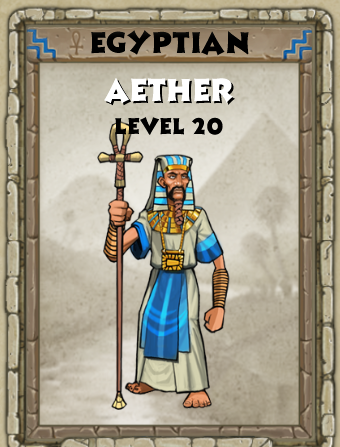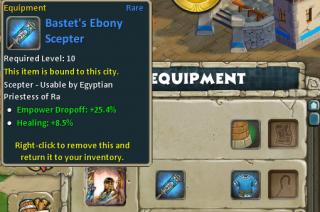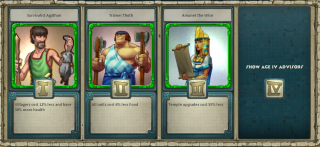Six Months of AoE:Online - Part 3
By makari 1 Comments
Hey guys!
In this edition of Six Months of AoE:O I'll be looking at the Egyptian Civilization in a little more detail. I picked the Egyptians initially because of their interesting mechanics that make them play much differently to the more straightforward Greeks. That and war elephants, can't forget the war elephants.
Walk Like An Egyptian

The Egyptian Civ in AoE:O is the more complex of the two available in the game at present. Their early game units are weaker toe-to-toe than the Greek units, but their late-game units are incredibly powerful (and expensive). To help them out a little with affording these expensive endgame units and to even the playing field in lower tech tiers the Egyptians have access to Priests, which are also pivotal in reaching the higher tech tiers.
The Egyptians are not as good in a straight-up fight early on as the Greeks are but they can mass early tier units incredibly quickly. Although this can be used to be aggressively as a rushing technique the Egyptian play style gravitates a little more toward being defensive early on and quickly building up a huge economy to advance in tech tiers faster than your opponent to sledgehammer the enemy with their meaty high-tier units and annoying Priest units. They are also better at obtaining victory through Wonder production due to their strong economy and fast-building capabilities.
Build More Religion
Religion is the pivotal focus of the Egyptian Civilization. While the Greek Civ simply spends resources to advance in tech tiers the Egyptian Age advancements are tied to religious buildings that train their useful Priest units and upgrades for them. There are three different kinds of Priest that the Egyptians have access to.
-Priestess of Ra-

In most cases the Egyptians will start with one Priestess of Ra to kick-start their economy, although they require a Temple of Ra (which advances tech to Age 2) to build. The Priestess is probably the most important part of the Egyptian Civs game as they are the only Priest type that can heal in combat and also the only kind that can provide the Empowered buff. Their healing powers can even up fights early on, making your low-tier infantry much more efficient, and become a serious problem for an opponent when they're providing even more survivability to your already chunky late-game units. With upgrades their healing power and range is increased and the 2nd Age movement speed tech makes them run about as fast as War Elephants which is awesome for keeping your late game army mobile.
The Empower ability is what gives the generally weaker Egyptian Civ its edge. A Priestess of Ra can be used on buildings to provide the Empower buff to that building. Empower can provide the following benefits to a building:
- Empower Dropoff - A Priestess channeling Empower on a resource dropoff point (such as a Town Centre, Storehouse or Dock) boosts the amount of resources dropped off by your villagers at that building by a percentage. This is what gives the Egyptians an economic edge: they literally get more resources than a Greek Civ. This makes Economy talents that raise the percentage of resources dropped off even more valuable to an Egyptian because the Empower buff is cumulative with those bonuses. Priestess gear can also make Empower Dropoff even stronger and is highly recommended.
- Empower Construction - A Priestess channeling Empower on a building under construction by villagers makes it build slightly faster. This buff stacks with the amount of villagers building the structure to make it build even faster. Suffice to say, this ability is useful for high tech buildings which take ages to make and even low-tier buildings like Storehouses and Houses build lightning-fast when a Priestess is Empowering them.
- Empower Training - An Empowered building that is researching tech or training units builds both faster than a non-Empowered structure. Egyptians build units and tech faster than a Greek Civ, which can give them an advantage of numbers to compensate for their weaker units. Note that this also works when upgrading a structure to a higher tier, like a guard tower or wall.
Empower bonuses also stack. For example, an empowered Town Centre will research tech faster, train villagers faster, and Empower resource dropoffs all with a single Priestess. The duality of the Priestess as an economy booster as well as a tech and army booster make it extremely important and valuable to playing Egyptians well.
-Priest of Set-

Priests of Set are built from a Temple of Set which advances tech to Age 3. Priests of Set can heal units when out of combat and cast Chaos on enemy units while in combat. They aren't exactly as pivotal as a Priestess of Ra, but can be useful for certain tactics. Priests of Set channel Chaos on enemy units and make them go Insane after a random amount of time depending on the units resistance to the spell. As a rule, higher tech units take a longer channel for the Chaos spell to proc on them. Insane units will attack any unit, friend or foe.
In a pitched battle this sometimes isn't quite as useful as the nearest units to the Insane unit are usually ones of your own anyway, but with proper control a Priest of Set can Chaos backline units to give you an edge in a fight. With upgrades you can do some really sneaky stuff like run them up to an opponents unguarded Storehouse and Chaos a few villagers, causing the Insane villagers to kill other gatherers.
-Priest of Ptah-

Priests of Ptah are trained at a Temple of Ptah which advances tech to Age 4, the final tech tier. Priests of Ptah are an annoying thorn in your opponents side. They are similar to a Priest of Set in that they can only heal out of combat and cast a spell in combat. Their spell is Conversion which, as you might have guessed, converts enemy units and buildings (!) to your side. Like a Priest of Set, the Conversion spell takes a random amount of time depending on the resistance of the unit or building to the spell. Converting villagers takes a very short amount of time, whereas converting a Town Centre takes a very very long time (and a very very silly opponent to pull off).
Ptah Priests are very useful in combat as they can literally bolster your army with enemy units in the middle of a fight. Other fun uses include ninja-converting Storehouses so that enemy gatherers cannot drop off resources at optimal points. Converting enemy tech and unit producing structures is possible but difficult to pull off. That said, an opponent who clusters his Houses away from the rest of their buildings and undefended could find themselves supply capped when you convert a bunch of them to your own.
The Army of the Shifting Sands
The army make-up of the Egyptians is kind of lopsided. Their early tier units are incredibly cheap and relatively weak, but their late-tier units are monstrously beefy and powerful. If you had to draw a little comparison to other RTS's, the Egyptian army is similar to that of the Zerg from Starcraft or the Tyranids from Dawn of War, the 'lings and 'gaunts of those armies being cheap and plentiful where the Broodlords and Carnefex are soul-crushingly expensive and strong.
-Age 1 and 2: Early Game-
The early tier units of the Egyptians are weaker than their Greek counterparts both in damage and health pool. In the early game an Egyptian isn't exactly the best at a frontal assault: None of their units are very sturdy or good against buildings, so unless they are backed up by a lot of Priestess' assaulting bases can be a costly strategy. With the Priestess' to back them up an Egyptian army block can be hard to move though and are better at assaulting bases than Greeks, and are especially strong if it is defending an attack behind walls and towers and can reinforce quickly. With Camel Riders an Egyptian is well equipped to counter cavalry harassment (Camel Riders are strong against other cavalry) and make harassment moves of their own, which is advised to keep your economic edge. Their available units lean toward a defensive strategy, but large blocks of infantry supported by a lot of Priestess' can be effective as an aggressive tactic.
The only offensive naval unit you have in the early game are Tiremes, which are only really useful at defending your other naval units. They are not particularly effective against any unit type but have no inherent weaknesses either.

Spearmen - Basic infantry unit. Strong against cavalry. Blocks of spearmen are good at cost-effectively weathering a cavalry-based attack, but not much else.

Axemen - Basic infantry unit. Strong against infantry. These will be your mainstay units early on as early pushes are generally infantry-based. Pretty solid with Priestess backup.

Slingers - Basic ranged unit. Strong against ranged. Slingers can be hard to use effectively as intended because their rock-paper-scissors is a little wonky and requires a fair bit of control. Slingers are an incredibly cheap way of dealing with mounted archers in the later game.

Camel Rider - Basic cavalry unit. Strong against cavalry. Camel riders are extremely fast and are your go-to unit for defending cavalry-based harassment and harassing enemy storehouses. They are not very sturdy so using them as a hammer in your army block is ill advised most of the time.

Tireme - Basic naval unit. Jack-of-all-trades, Tiremes are neither great or terrible against anything except of course enemy Fireships. They are your only choice for sea-based defence in early game and are best used for defending your fishing boats early on.
-Age 3: Mid-game-
Mid-game is where an Egyptian army starts to get some meat on its bones. Egyptian mid-game has excellent harassment options in the Priest of Set and Chariot Archers. Chariot Archers are a great overall unit, they are fast, strong, and can kite effectively. With Chariot Archers and Camel Riders the Egyptians can gain a lot of map control in the mid-game to resource-starve their opponents and quickly retreat if things get dicey. They also gain access to War Elephants, which are the Egyptians main hammer unit. They can have trouble against large blocks of enemy cavalry, although with Priestess' healing them their splash damage can equalise things, and they rip through pretty much any other unit and building. The downside of course is that they cost an arm and a leg and take a long time to train. Egypt also get siege towers in this Age, and are cheaper and slower alternatives to War Elephants for breaking down walls, buildings and defensive structures. They are painfully slow and vulnerable but are a cheaper way of quickly breaking a wall and harassing inside a base.
On the naval front Egypt gains the Fireship in Age 3. Fireships are excellent against all other ships. Whether defending or attacking, Fireships make short work of any and all enemy ships from fishing boats to siege ships. Whoever has more Fireships has naval superiority, to put it bluntly.

Chariot Archer - Ranged Cavalry unit. Extremely fast, extremely effective at harass. Can kite infantry units exceptionally well.

War Elephant - The hammer of the Egyptian army. Huge health pool, huge splash damage, effective against everything, faster than infantry but slower than light cavalry. Painfully expensive, susceptible to siege. Are technically weak to enemy cavalry, but splash damage equalises the matchup in a pitched fight.

Siege Tower - Effective against buildings. Cheaper to make than a War Elephant but without the additional perks of ability to be healed and being able to attack enemy units. Extremely slow and vulnerable.

Fireship - Naval superiority unit. Demolishes any type of ship in a few shots. Weak against... other Fireships.
-Age 4: Late game-
Age 4 is the big pay off for an Egyptians patience and economy building even though their biggest spike in strength happens in Age 3. Egyptians gain Elephant Archers in Age 4, which are basically ranged War Elephants that are a little less adept at smashing buildings. Elephant Archers make infantry blocks nigh on useless unless they are hard countered by enemy cavalry, but with Egypt's light cavalry hit squads and War Elephants this shouldn't be as much of a problem. Catapults are made available, as well as Catapult Tiremes, which are land and sea-based siege units respectively. Siege is good against any unit and building and causes splash damage with the downside of being slow and having a low rate of fire. Palintonons are the final Age 4 unit, and if you've played Starcraft then the comparison here is simple: they're Siege Tanks. Palintonons are even slower than catapults but have insanely long range (as long as you have vision from another source) and literally drop buildings in a couple of shots, as well as being effective against any type of unit and causing splash damage. Like Siege Tanks they need a little time to set up and so are vulnerable to flanking attacks.

Elephant Archer - Extremely powerful heavy ranged cavalry. All the perks of a War Elephant, at range, without the building-crushing abilities. Destroy infantry blocks, susceptible to enemy cavalry and siege.

Catapult - Basic ranged siege unit. Cheaper than a Palintonon, shorter range and less effective against buildings (but still very effective!). Strong against all units, deals splash damage.

Palintonon - Heavy siege unit. Longest range in the game, slow and takes time to set up. Demolishes buildings, strong against all units, deals splash damage.

Catapult Tireme - E'rybody look at me, I'm a catapult on a boat. Good at bombarding enemy buildings from the sea, make sure they're supported by Fireships though.
Jewels of the Nile - Outfitting the Egyptians

As you can probably tell by now, Egypt is a very econ-driven Civilization. Its weak units are cheap and fast to produce, its strong units incredibly expensive. With that in mind, when gearing out your Egyptians, choosing advisers, talents and crafting specializations you should lean toward ones that will make your economy and economy management better. Being richer than your opponent and spending those resources wisely is a big part of what Egyptians are all about. Good gear for your Priests and Villagers should have things like Empower bonuses, spell rate increases, and movement speed and gathering bonuses. Talents that raise the percentage of resources your Villagers can carry and drop off are valuable as well. In later levels it can be worth investing in Market talents, as the Star Talent for Markets give you passive resource generation, not to mention a healthy and steady source of gold.

Having one of your crafting specializations as Religion helps out a lot with gearing your Priests with handy items and has some awesome economy-based special skill cards like Discover Mine, which can give you a boost to early economy. Craftsmen is another good choice to boost your economy, or Construction if you want quick and strong defences and fortresses.
When picking Advisers, I like to pick ones that make key units cheaper and more effective. Advisers that help your Villagers and Priests in some way are great, as are ones that reduce costs of your expensive units (Trainer Thoth for example reduces the food cost of all units, which helps early on and scales well in late game). I tend to pick an econ or unit-based Adviser over the Elite Unit Advisers so far, as they seem more important to how the Civ plays. Elite Units are Age 3 units which doesn't help at all with bolstering your early game and eat into your late-game unit spending, so they seem counter-productive.
Closing Thoughts
Hoped you like the fairly brief overview of the Egyptian Civ. Playing 20 levels of them and getting to try out all their units I've come to like them a lot. The Empower mechanic as well as the payoff for good macro in the form of really satisfying endgame units make for a cool experience. I think, from what I've played so far of the Greeks, that Egypt is the more forgiving PvE race, at least early on. The Priestesses kinda offset the weakness of your troops in situations where you make a lot of them for your infantry blocks, and being able to heal meaty units like the War Elephant in combat makes them really hard to lose.
In PvP though it feels like it's the other way around. Egypt needs to constantly be on top of defending their precious economy and watching out for Priestess snipes while making a decent enough army to hold off any pushes until Age 3, unless you go the PvE zerg-with-Priestesses-and-Axemen route which can work against some opponents.
Looking forward, I'm going to start playing the Greek Civ and jotting down my thoughts in smaller posts as I play through the missions. Hopefully there'll be something substantial there before the Persians and Celts are released (apparently both before the end of the year) with all the other games distracting me from AoE:O.
Thanks for reading!

1 Comments